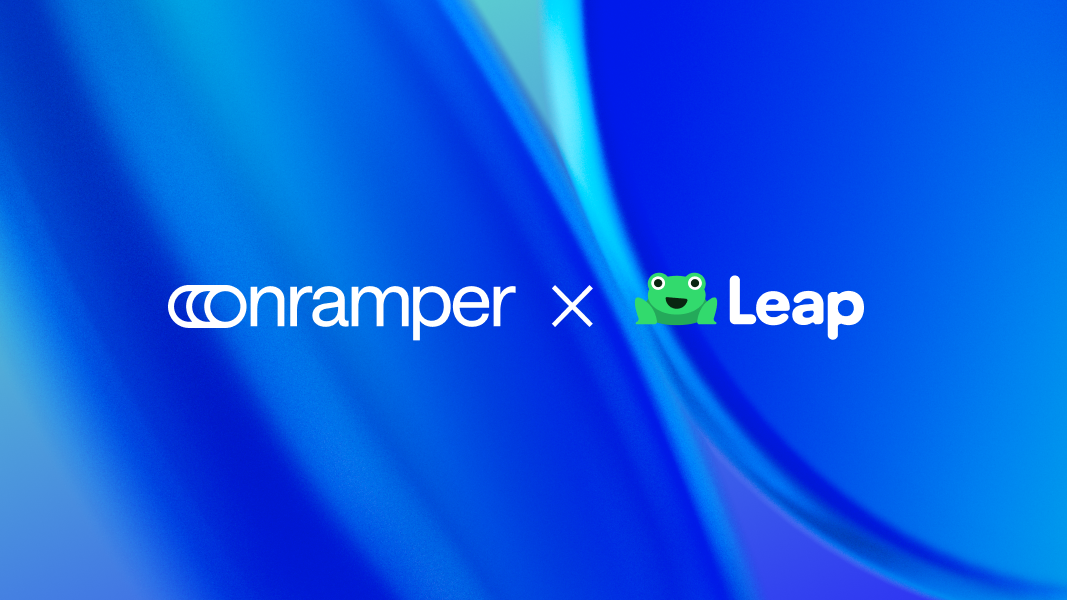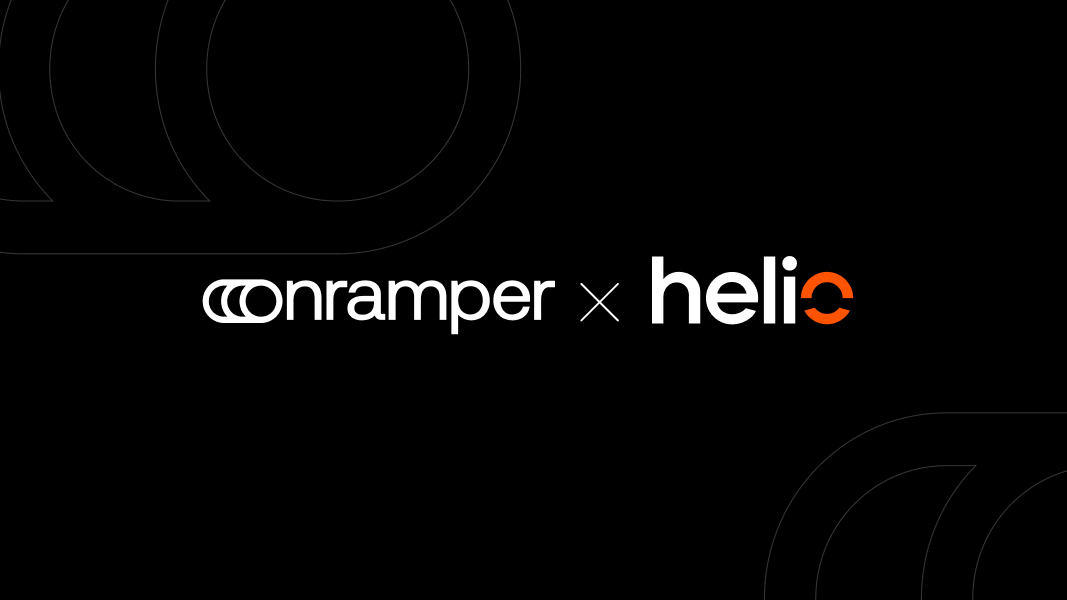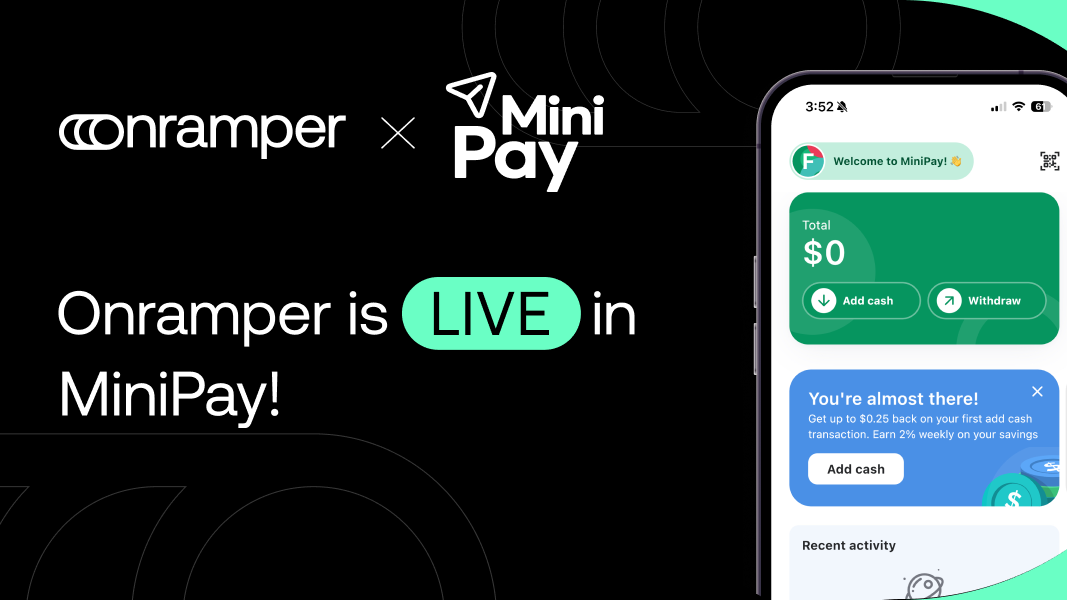Blog
Six misconceptions about fiat onramp aggregators
Separating fact from fiction can be tough in such a fast-moving industry. Find out why the top concerns about aggregators are actually wrong.

Fiat-to-crypto onramp aggregators are gaining traction as the go-to solution for platforms that want to reduce integration time and provide a more seamless onboarding experience for their customers.
As they grow in popularity, however, so do the myths surrounding their performance, pricing and general effectiveness.
In this article, we’ll debunk the most common ones we’ve seen.
1. Aggregators result in higher fees for end users

By definition, this is false.
When using a single onramp, platforms lock their customers into restrictive fee regimes – where they’re at the mercy of whatever conversion rates, network fees and other costs the onramp chooses to leverage. The ‘fixed fee’ quoted by your onramp provider doesn’t account for these.
An aggregator, on the other hand, gives your customers much more flexibility. Based on their payment method, fiat currency and desired crypto, it can calculate (in real time) which onramp is most competitive on fees.
What’s more, an aggregator can typically negotiate lower rates than a single platform ever could: as Onramper generates high volumes and a good negotiating position with partners, we can ensure that no fees are added on top of the onramp’s.
In short: aggregation almost always secures lower fees for your customers.
2. Aggregators create compliance and security risk

What if one of the aggregator’s supported onramps suffers a security breach or fails to meet an acceptable level of regulatory compliance?
This is a valid concern. Inevitably, some onramps will be less secure and less compliant than others. In a worst-case scenario, you could be facilitating a transaction for bad actors via your platform.
But this isn’t an aggregator problem: it’s an onramp one. And a competent aggregator won’t add onramps without performing extensive due diligence beforehand — just as you wouldn’t. Even then, most integrations will allow you to enable/disable onramps based on your own risk model.
In the event of an unforeseeable security breach, onramp failure, or onramp default, an aggregator is actually beneficial: it won’t leave you stuck with a broken onboarding solution. At any given moment, your customers have several fallback options ready to go.
3. Aggregators are more difficult to integrate

Incredibly wrong. However, it’s something we’ve heard before, so it’s worth addressing.
One of the strongest value propositions for aggregators is their ease of integration. Instead of integrating, maintaining and juggling several onramps, businesses like yours can free up massive amounts of time and resources with a single solution.
Setup time varies. But, with Onramper, you can harness the power of a vast ecosystem of onramps with just eight lines of code (yes, really). If that’s not easy enough, you can rest assured that you’ll never need to troubleshoot or maintain onramps again — we handle all of that so you can focus on what you do best.
4. Aggregators offer an inferior user experience than an onramp

Not necessarily. At its core, an aggregator is a matching engine that automatically points your customers towards the correct onramp.
Since it usually taps into onramps’ APIs, an aggregator rarely requires the user to take a different course of action than if they were buying via a regular onramping widget.
At worst, some performance friction could arise if the matching engine was slow. But that’s not an issue for the top aggregators. Our own dynamic transaction routing system crunches over 70 factors to near-instantly connect customers with their perfect onramp.
On the surface, this process is so seamless that you’d be forgiven for thinking it was a regular, single onramping widget.
If anything, Onramper’s aggregator actually improves the user experience: low-KYC routing offers up the solution with minimal KYC required, and returning-user routing directs users to onramps they’ve previously used successfully.
5. Aggregators lack transparency

It may be true for some, but not for all. And certainly not for Onramper.
In fact, on the fee front, our stack is far more transparent than a single onramp’s. Instead of selecting a route based on quotes provided by onramps, we select it based on the amount of crypto received. In short, this ensures that users always get the best bang for their buck — without getting stung by the hidden costs that single onramps usually incur.
As for general transparency around onramping data? We make sure our customers have unmatched oversight, across the entire ecosystem, of how well each onramp is performing (thanks to the Onramper Terminal).
6. Aggregators don't work if you already have an onramping partner

Again, it may be true for some. But, personally, we love it when our customers come to us with established relationships. In fact, we’ve optimized the platform for it.
With Onramper, you can directly import your existing API keys. Via the Onramper Terminal, you can even compare their rates against ones from your new suite of onramps — ensuring that, no matter what, your users will always get the best rates.
Making the switch from a single onramp to an aggregator can be daunting. But it doesn't have to be. In just eight lines of code, you can integrate Onramper to immediately start boosting your success rates. Here's how.
Other articles

Leap Wallet integrates Onramper for exclusive fiat-to-crypto onramping
Leap Wallet has entered into an agreement with Onramper to power fiat on- and off-ramping across its mobile applications and browser extension.
Leap Wallet has entered into an agreement with Onramper to power fiat on- and off-ramping across its mobile applications and browser extension. The integration brings Onramper’s global infrastructure directly into Leap Wallet, enabling streamlined access to crypto for users around the world.
Since 2025, Leap Wallet has expanded beyond its initial focus on the Cosmos ecosystem to become a multi-chain wallet. Today, it natively supports Bitcoin, Ethereum, and over 200 additional blockchain networks, allowing users to manage assets across a wide range of ecosystems without switching platforms.
“As Leap Wallet has grown into a multi-chain platform, demand for a seamless onramping experience has surged,” says Sanjeev Rao, CEO of Leap Wallet. “Our mission is to streamline the flow of value across ecosystems—and by partnering with Onramper, we’re eliminating key barriers for users.”
Enhanced onramping coverage
With this significant expansion, Leap Wallet recognized the necessity of robust and accessible onramping solutions to serve its growing user base. To address this, Leap Wallet is now integrating Onramper exclusively. This partnership allows users to:
- Access onramping for thousands of tokens
- Benefit from coverage across 200+ blockchain networks
- Enjoy frictionless fiat-to-crypto transactions, catering to both new and experienced users
By leveraging Onramper’s capabilities, Leap Wallet ensures its users experience reliable, broad, and convenient access to a wide range of cryptocurrencies, further reinforcing its position as a top-choice multi-chain wallet for global digital asset management.
“Crypto users need fast, secure, and reliable access to liquidity,” says Thijs Maas, CEO of Onramper. “Through this partnership with Leap Wallet, we’re bringing our global onramping infrastructure directly into one of the most advanced multi-chain platforms, enabling seamless value movement at scale.”
To learn more, visit onramper.com and leapwallet.io.

Helio Partners with Onramper to Power Unique Card to Stablecoin Payments for Global Merchants
Onramper’s industry-leading aggregator will localize payment methods for merchants looking to accept instant stabelcoin payments.
May 20, 2025 – Onramper, the world’s leading fiat-to-crypto on-ramp aggregator, today announced a partnership with Helio to supercharge stablecoin payments for global merchants. Helio, a leading crypto checkout app used by over 6,000 merchants and millions of users, has advanced the adoption of crypto payments by offering a faster, more affordable alternative to traditional methods.
To date, Helio has processed over $1.5 billion in transactions and integrates with leading digital platforms, including Shopify, where it powers the popular Solana Pay plugin. Now, the company is launching a revamped payment flow that enhances the onboarding experience for new users that don’t already have a crypto wallet when completing purchases with stablecoins such as USDC.
Now when Helio users select “Pay with Card”, they’re guided through a localized payment method selection screen tailored to their region powered by Onramper’s industry leading on-ramp aggregator and smart routing engine. Users can quickly fund a virtual crypto wallet tied to their email by purchasing USDC and easily complete their payment to the merchant. This seamless fiat-to-crypto flow unlocks valuable new commerce use cases for merchants, including instant settlement from credit card purchases (instead of next day settlement), zero chargeback risk, seamless iGaming deposits via cards, global support for high risk payments and more.
Stablecoin usage continues to rise – recent reports show retail usage increased by 35% in 2024 as consumers increasingly turn to stablecoins for e-commerce to avoid banking delays.
“Collaborating with Helio to enable stablecoin payments is a major step toward bringing crypto commerce to Web2-native users,” said Thijs Maas, CEO of Onramper. “Our aggregation engine delivers localized on-ramps and payment methods, making it easier for users to check out.”
Onramper accepts 130+ payment methods and enables users to purchase crypto across 190+ countries. This extensive geographic coverage is complemented by sophisticated routing engines that recommend the best conversion for users in real-time – maximizing users’ odds of a successful transaction and ensuring they receive the most crypto for their fiat.
"Helio is known as the market leader in native crypto payments, offering low fees and instant settlement. With the integration of Onramper, we’ve expanded backwards compatibility with the traditional financial system. This allows Helio merchants like Liquid Brokers and Bizcuits to accept instant card payments in over 130 countries through seamless fiat to stablecoin onramps. This results in increased sales for our merchants and a faster, smoother checkout experience for customers at Helio-powered stores. It’s a big step toward making crypto payments as seamless as traditional ones, especially for those new to crypto or looking to top up quickly." said Stijn Paumen, CEO of Helio.
“At Bizcuits, we support trading brokers and prop firms with operational solutions, including payments infrastructure. We integrated Helio for card-to-crypto payments because of its seamless experience, transparent pricing, and global reach. It enables our partners to offer reliable fiat-to-crypto onramps without added complexity, making Helio a natural fit for our ecosystem.” Debbie Colerio, Payments and Compliance Manager, Bizcuits
To learn more, please visit onramper.com and hel.io.
About Helio
Helio provides a suite of payment tools for merchants, creators and platforms, making it easy for anyone to accept USDC and other digital currencies. Designed for ease of use, especially those new to crypto payments, Helio is a faster and more cost effective alternative to traditional payment methods. Empowering over 6,000 sellers and over one million users, Helio supports major blockchains including Solana, Bitcoin, Ethereum and L2s.
About Onramper
Onramper is the leading fiat-to-crypto payments aggregator, providing a turnkey API-based solution for dynamically routing fiat-to-crypto onramp flows based on algorithms optimizing for conversion, fees and payment methods. Onramper’s platform allows users of clients to buy 2000+ digital assets, in over 190 countries with over 130 payment methods in 120 currencies, with advanced routing options and unified analytics. The company is based in the Netherlands. To learn more about Onramper, visit www.onramper.com.

Onramper Partners with Opera’s MiniPay to Expand Global Access to Stablecoins
MiniPay will tap into Onramper’s industry-leading on- and off-ramp aggregation infrastructure to broaden stablecoin accessibility.
May 13, 2025 – Onramper, the world’s leading fiat-to-crypto on-ramp aggregator, today announced a partnership with MiniPay – Opera’s stablecoin wallet – to expand the accessibility and utility of stablecoins for users worldwide. Stablecoins are rapidly gaining momentum as a medium of exchange, facilitating remittances and streamlining cross-border payments while promoting financial stability and inclusion. In 2024 alone, annual stablecoin transfer volume reached $27.6 trillion – surpassing the volumes of Visa and Mastercard combined.
Opera, the global web innovator with nearly 300 million users, first unveiled MiniPay in September of 2023 as an embedded feature within Opera Mini – the browser of choice for users across Africa. A dollar stablecoin wallet built on Celo, MiniPay offers seamless global peer-to-peer transfers at sub-cent fees using simply mobile phone numbers. It features easy onboarding with key backup through Google and now iCloud.
Since its launch, MiniPay has grown to over 7 million activations across 50+ countries, enabling fast, secure, and intuitive stablecoin transactions with an emphasis on accessibility and utility.
Today, MiniPay will tap into Onramper’s industry-leading on- and off-ramp aggregation infrastructure to broaden stablecoin accessibility.Onramper supports 25+ onramps and 130+ local payment methods, while its off-ramp product covers seven off-ramps, supporting 46 fiat currencies and 500+ cryptocurrencies.
“Stablecoins have emerged as one of the most impactful use cases for digital assets, with regions like Latin America embracing them for low-cost remittances and as a hedge against monetary instability,” said Thijs Maas, CEO of Onramper. “Collaborating with MiniPay allows us to onboard more users in SEA, LatAm, and beyond into the stablecoin ecosystem, using a gateway as simple as a mobile phone number to get them started.”
As of May 13, 2025, MiniPay officially launches as a standalone app for iOS, meaning it is now present both within Opera Mini and the Google Play and App Stores, making it a truly global stablecoin wallet. Key features of MiniPay include:
- Send and receive stablecoins in seconds using just a phone number
- Buy and sell USDT, USDC, and cUSD stablecoins with zero fees
- Access real-world use cases like paying for utilities, buying gift cards, redeeming vouchers, and more
- Localized cash-in and cash-out across a variety of local currencies
“MiniPay isn’t just another Web3 wallet, it’s a product designed for people who live globally, work remotely, and need fast, affordable access to digital dollars. Onramper gives us the rails to make that experience seamless for users around the globe,” said Jørgen Arnesen, EVP of Mobile at Opera.
MiniPay is now live across iOS and Android in countries including the US, Canada, Brazil, Germany, Nigeria, Kenya, Ghana, South Africa, and more. You
To learn more, please visit onramper.com and minipay.xyz.

















